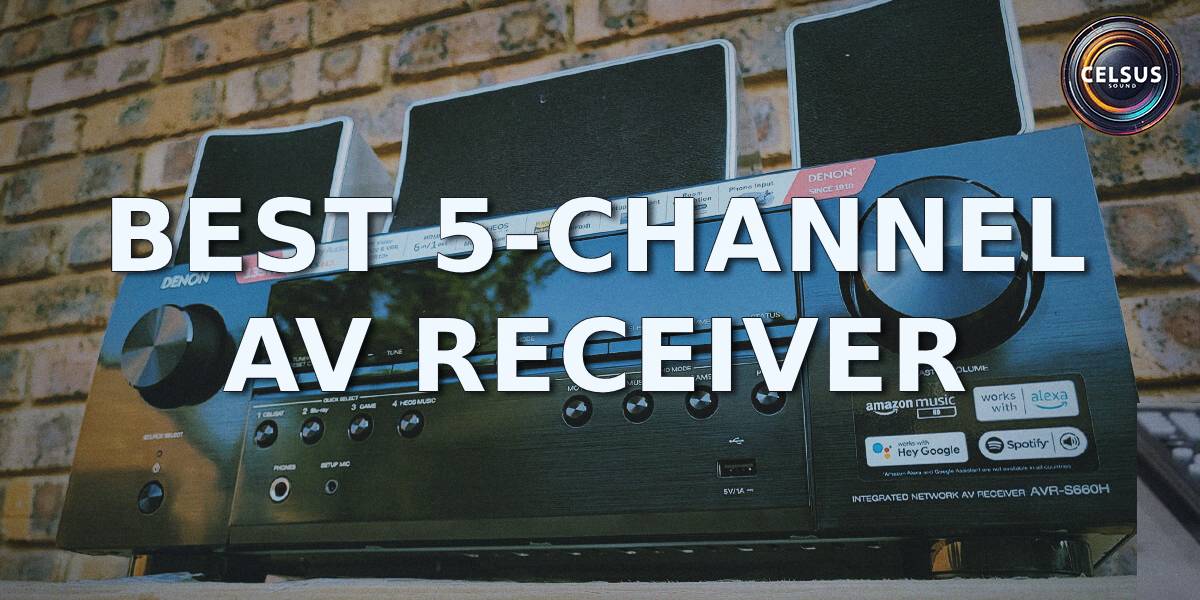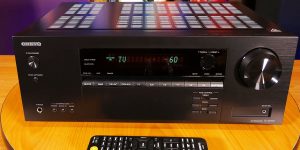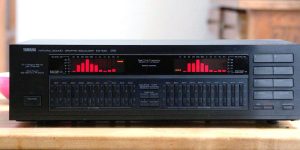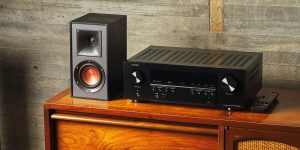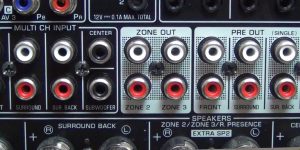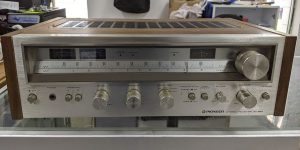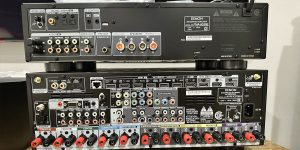In the world of home theaters, the audio experience is just as important as the visual. And when it comes to creating a rich, immersive sound, a high-quality receiver is a must-have. In this article, I will take a closer look at the best 5 channel receivers, discuss what sets them apart from other options, and highlight what makes the receivers listed in my list the coolest options available on the market. Five-channel receivers are popular for those looking to create a surround sound setup in their home theater without spending much money.
With the current market conditions, there are many options to choose from, making it challenging to find the right one for your needs. However, picking an AV receiver for 5.1 surround sound is a golden mean because this setup is relatively cheap, easy to build, and still provides a stunning surround sound quality. So, today I will help you make the optimal decision based on actual tests and experience.
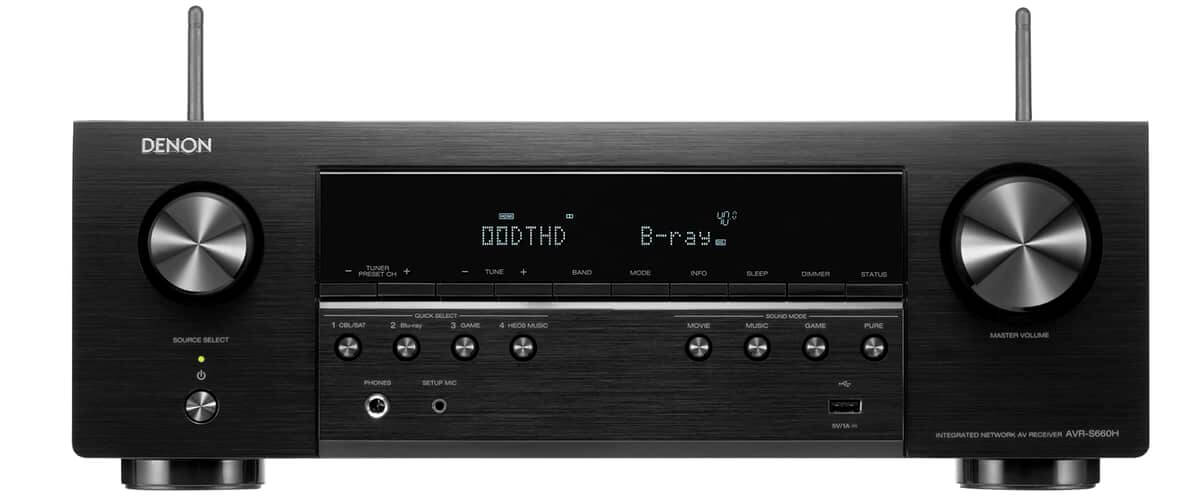
5.1 AV receiver comparison table
| Name | Channels | Power output | HDMI in/out | Bluetooth/Wi-Fi | Review |
|---|---|---|---|---|---|
| Denon AVR-S670H best overall | 5.2 | 75W/8 Ohm, 100W/6 Ohm | 6/1 | yes/yes | Review |
| Marantz NR1510 premium | 5.2 | 50W/8 Ohm, 60W/6 Ohm | 6/1 | yes/yes | Review |
| Sony STRD-H590 budget | 5.2 | 145W/6 Ohm | 4/1 | yes/no | Review |
What is a 5.1 home theater system?
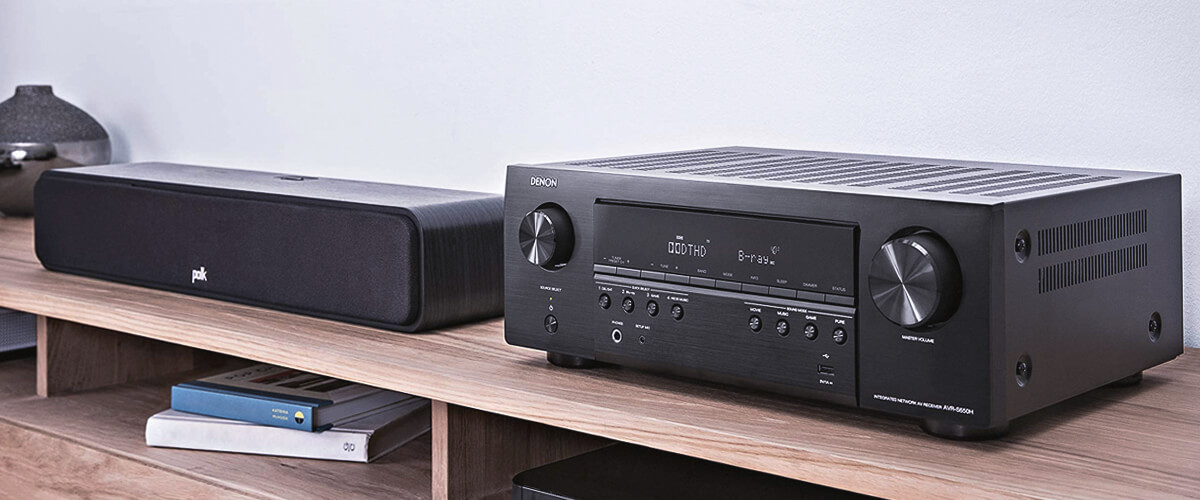
A 5.1 home theater system is a setup that consists of five speakers and one subwoofer, hence the term 5.1. The “5” represents five speakers, while the “1” represents the subwoofer. The five speakers include a center channel, two front, and two rear speakers. This configuration is designed to create a surround sound experience that mimics how sound works in the real world.
At the same time, despite clear pros, the 5.1 and 5.2 systems also have certain disadvantages. For example, while a 5.1 system provides a good surround sound experience, it can be limited compared to higher-end systems such as 7.1 or 9.1. Another problem, especially for inexperienced users, is that setting up a 5.1 system requires careful placement of the speakers, which can be difficult in small rooms. Finally, there is also a concern about the future, as 5.1 systems are becoming less common as newer technologies gain popularity.
What to look for when choosing a 5-channel AV receiver
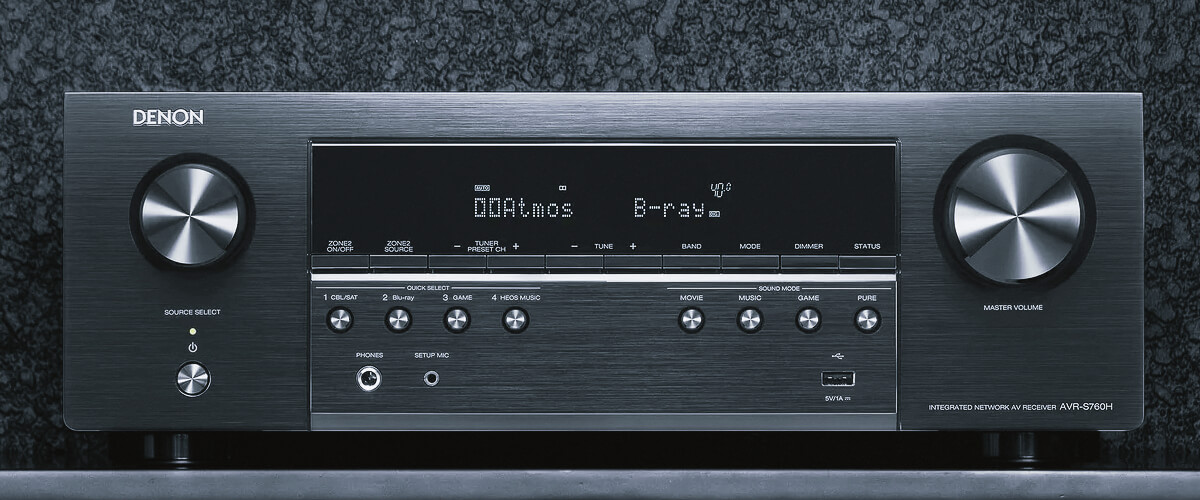
So, you’ve decided to opt for a 5-channel receiver. Well, that’s fine. Before you move on to the models themselves, I want to tell you what to pay attention to when choosing such a device.
Connectivity options (HDMI, Wi-Fi, Bluetooth, etc.)
Considering the fact that AVR is a device that connects and integrates the work of many different external components, its capabilities in this aspect are very important.
HDMI inputs/outputs. You should first be concerned about the number of ports and the HDMI version. The more ports you have, the more different components you can connect to your receiver. The latest HDMI version guarantees support for options like HDCP 2.2, eARC, and end-to-end 4K/8K video transmission.
Wireless connectivity. Features like Wi-Fi, Bluetooth, and even proprietary wireless solutions are maximized for audio streaming or integration with other devices. In this era, a receiver with limited wireless capabilities is like a car with three wheels.
Analog and digital inputs. You may have outdated equipment or different audio sources. To ensure this is not an issue for you with a particular receiver model, look for analog and digital inputs.
User interface and ease of setup
Remote control. Look for models with simple and straightforward controls. This is the golden rule, especially for beginners. By the way, many receivers (e.g., Denon, Marantz, or Yamaha) offer proprietary smartphone remote control apps. So, make sure that the receiver model you choose supports this control method.
Auto-calibration. Almost all modern receivers are equipped with special microphones that can automatically calibrate the speaker levels depending on the acoustics of your room. According to my observations (as well as feedback from other experts), the system from Denon – Audyssey MultEQ works better.
Price
Modern 5-channel receivers are mostly affordable for most users. Their cost varies from 500 to 1000$ depending on the year of release, brand, and features. It would be a mistake to think that all such devices are unreliable and low-quality options. Many of them provide quite a decent set of features and characteristics.
Additional features
Apart from the basic features, some receivers of this rank are equipped with certain additional features that can be useful for you.
Music streaming
We’re all a bit of music geeks, and if you’re planning to buy a receiver, you’ll obviously want to use modern music streaming services such as Spotify, Apple Music, Amazon Music, etc. So look out for models with these features. I’ll let you in on a secret: my review has them.
Smart home compatibility
Integration with voice assistants such as Alexa, Google Assistant, or Siri can be a useful option for some users. You probably know about their advantages if you have already tried these technologies. If not yet, I advise you to definitely give it a try. Try to keep up with the times, it offers a lot of advantages.
Multi-zone capability
A great way to create independent audio zones in your house or apartment. If you live on your own, it may not be so important, but if you have a large family, this feature can be very useful. It is really convenient, so be sure to pay attention to receivers with this option.
Pre-outs
Pre-outputs can be very useful if you plan to expand your system or add an external amplifier. It may not seem very important at first, but you will want improvements over time (as you gain experience). That’s why having these outputs can come in handy.
| Article navigation |
|---|
| Denon AVR-S670H – best overall |
| Marantz NR1510 – premium pick |
| Sony STRDH590 – budget |
| Yamaha RX-V385 |
| Pioneer VSX-534 |
| FAQ |
Best 5.1 receiver reviews
Denon AVR-S670H – best overall

The Denon AVR-S670H is a mid-range AV receiver designed for home theater and multiroom audio use. The manufacturer markets this unit as a cost-effective, feature-rich alternative for people wishing to enhance their home entertainment system. It was released in 2019 and still has all the chances to be the best 5.1 receivers. The AVR-S670H has several benefits over other models in its class, including support for the newest video and audio formats and cutting-edge room calibration technology.
The Denon AVR-S670H has no surprises in terms of design, as the company sticks to traditions and wants to stay the same. It weighs about 18 pounds and has dimensions of 6 inches in height, 17 inches in width, and 14 inches in depth. The ports and connectors are located on the back panel, while the display screen, volume control, and input selector buttons are located on the front panel. Talking about the display, it is one of the coolest in its class: readable, of good quality, and simple to navigate. The chassis is rigid and reliable, and navigating and using the control surfaces is simple.
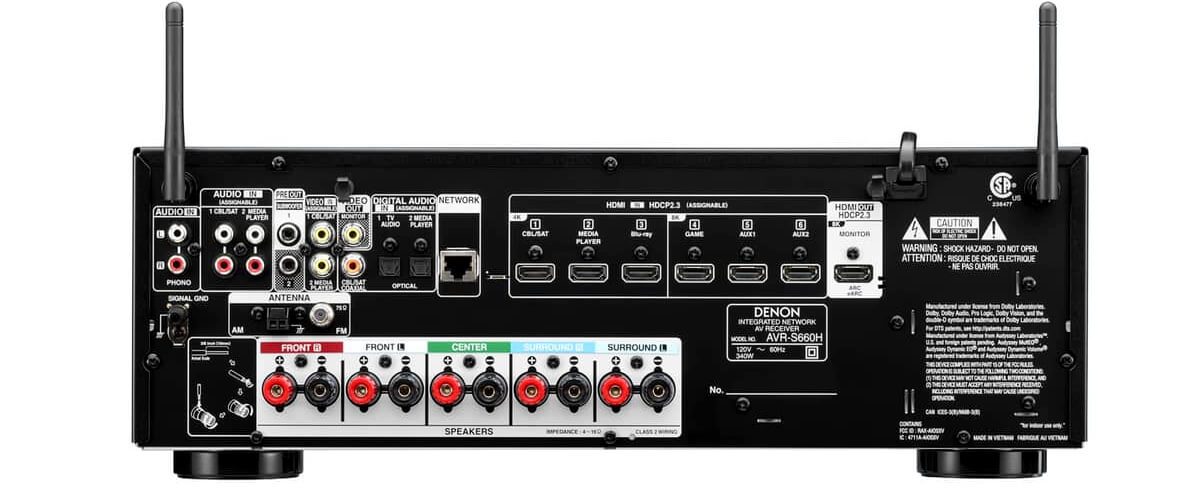
The Denon AVR-S670H is a 5.2-channel receiver capable of producing 75W of power with an 8-ohm impedance and a frequency range of 20 Hz to 20 kHz with 0.08% total harmonic distortion when driving two channels. At the same operation with a 6-ohm impedance, the receiver can produce 100W of power at 1 kHz with 0.7% THD.
It supports 4K Ultra HD, HDR, Dolby Vision, and HLG video formats and features 6 HDMI inputs and a single HDMI output, with HDMI 2.0a support for HDCP 2.2. It also has built-in Wi-Fi and Bluetooth and is compatible with popular streaming services such as Spotify, Apple Music, and Amazon Music. The receiver offers DTS HD Master, DTS Neo:X, Dolby TrueHD, and Dolby ProLogic II. The AVR-S660H has an advanced room calibration system called Audyssey MultEQ XT, which adjusts the audio output based on the room’s acoustics and speaker placement. It also supports zone stereo downmix and a phono input for turntable playback.
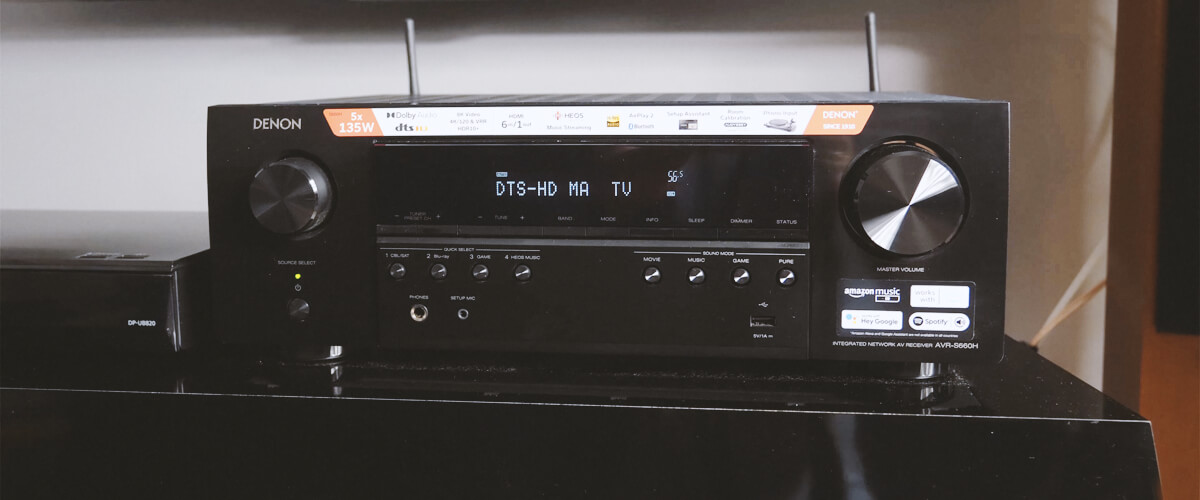
The sound of the Denon AVR-S670H is not as outstanding, but because it is the 5.1 AVR. If we talk about the quality, it is at a high level compared to other models in my rating. Perhaps only Marantz NR1510, which is more expensive, can compare with it in transmitting warmth, realism, and detail. In movies, the sound blends into a single mess and offers a layering of backgrounds very close to the actual ones. It’s not a bad bass response, but you’ll need powerful subs for them to fulfill the AVR-S660H’s potential. As always, I have no complaints about HEOS; everything will be enough for music lovers.
You will get a model that is equally good in sound and video for modest money. This is a great rarity, especially for budget and mid-range devices. Because of this optimal ratio of the main aspects, I consider Denon AVR-S660H the best 5.2 receiver in my review. Powerful enough for its configuration, it supports 8K video (as the model has been updated since its creation), a huge set of features for music lovers. Inferior in design quality except for the more expensive Marantz NR1510.
Key specs
- Channels: 5.2.
- Power output: 75W/8 Ohm, 100W/6 Ohm.
- HDMI inputs/outputs: 6/1.
- Video functions: 4K/60Hz, 4K/120Hz, 8K/60Hz pass-through, upscales HD video signals to 8K Ultra HD.
- Bluetooth/Wi-Fi: yes/yes.
- Streaming services: AirPlay 2, Pandora, Spotify, Napster, SiriusXM, TIDAL, Deezer, Qobuz, Amazon Music.
- Suppots: HDMI ARC, HDMI eARC, HDMI CEC, HDCP2.3, HDR10+, Dolby Vision.
- Surround sound: DTS HD Master, Dolby TrueHD, Dolby ProLogic II.
Pros
- Support of HDR10+.
- HEOS Multiroom and Streaming.
- Flexible connectivity options.
- A great balance of price and performance.
Cons
- No Dolby Atmos support.
Marantz NR1510 – premium
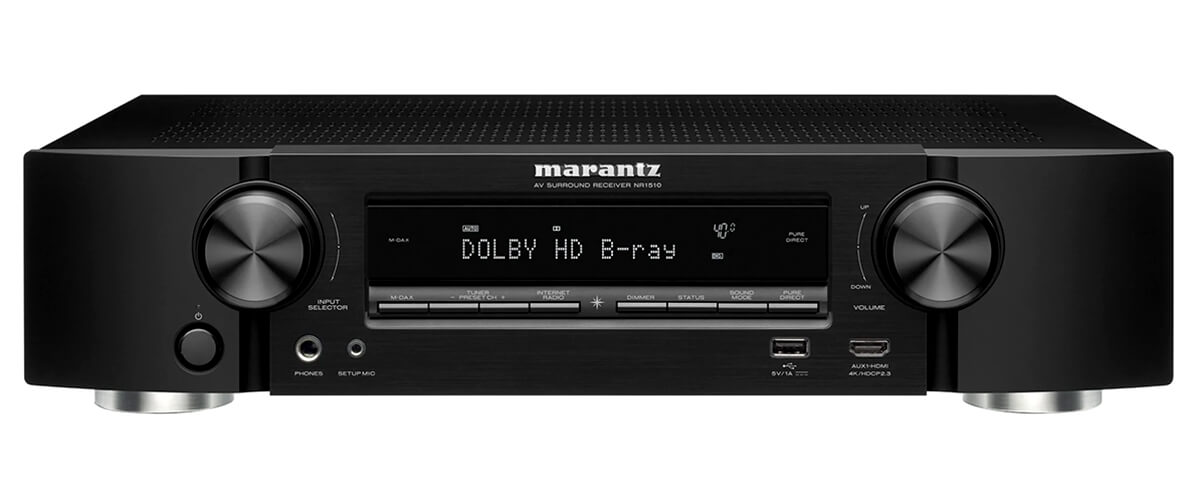
The Marantz NR1510 is a slimline 5.2 channel AV receiver released in 2019. Marantz positioned it as an efficient solution for high-end home entertainment systems. The manufacturer emphasizes that the NR1510 is compatible with a wide range of audio and video formats and is easy to set up and use. So, it should be a precious option, but is it true?
The Marantz NR1510 has a modern rounded design that makes it an excellent fit for any current home entertainment system, as it genuinely looks fresh and new. At the same time, the unit follows the standard layout: the control surfaces are located on the front panel, which includes a display, input selector, volume knob, and several buttons to adjust the settings. In terms of size, it measures 4.1 inches in height, 17.3 inches in width, and 14.9 inches in depth. The NR1510 weighs around 18.3 lbs, which is lighter than the Denon AVR-S660H.
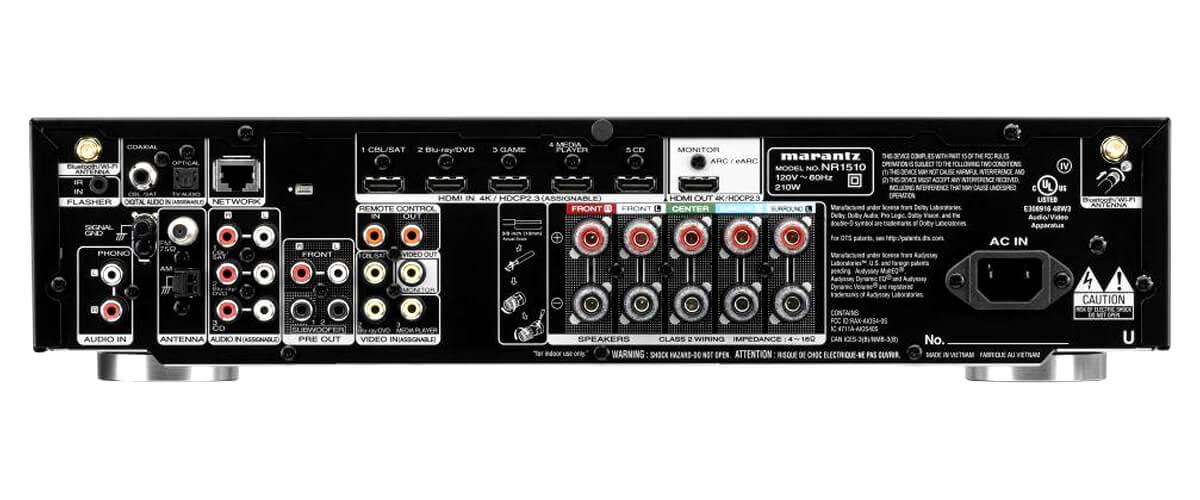
The NR1510 has a rigid and nicely-built body with a premium look and feel. The unit features a large LED display and control buttons and surfaces on the front side. Honestly, the controls’ layout is so typical for the receivers, so it is hard to distinguish this model by it. Everything is located precisely where you expect it to be. A logical layout and intuitive button placement are definitely a good side. Facing the Denon AVR-S660H, the Marantz NR1510 is slimmer and lighter, making it a more space-efficient choice for smaller rooms.
The Marantz NR1510 can operate with speakers with an impedance of 6 ohms and a power output of 50 watts per channel with an 8-ohm load. The NR1510’s amplifier comprises discrete power transistors with a high current. Moreover, it contains a 32-bit AKM AK4458VN digital-to-analog converter (DAC) that can process 24-bit/192kHz high-resolution audio files. Furthermore, the receiver has Audyssey MultEQ XT, a cutting-edge room correction system that may optimize sound quality based on the acoustics of your room.
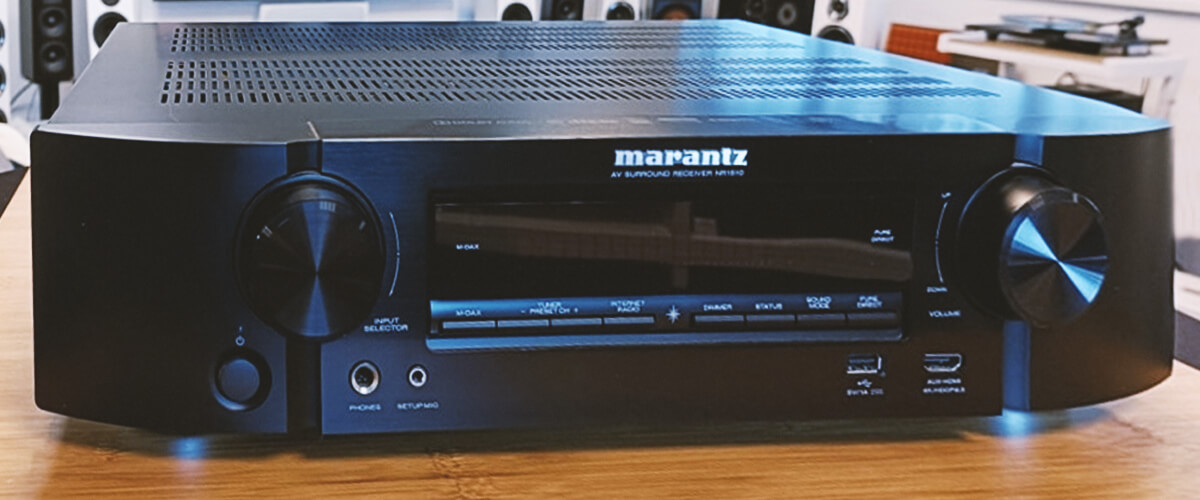
The NR1510 contains an essential set of ports and connectors, including an Ethernet port for a wired internet connection, digital optical and coaxial inputs, USB input, phono input, six HDMI inputs, and one HDMI output with ARC and eARC support. For wireless connectivity, it also features built-in Wi-Fi and Bluetooth and supports some streaming services, including Tidal, Apple Music, Spotify, and more.
The Marantz NR1510 has shown outstanding results in music and movies. Typically, for Marantz, in movies, it delivered a warm and rich sound with a smooth and detailed mid-range. Marantz sticks to their typical sound signature that emphasizes musicality and naturalness. Even during action moments, the unit delivered clearly and showed almost the same detail level as the AVR-S660H from Denon. Yet, the NR1510 strongly depends on speaker quality. While the AVR-S660H can work with cheaper speakers and still deliver good sound quality, the NR1510 struggles and can only show quality with corresponding speakers.
Moreover, due to its narrow design, the model in question is very low-powered. Unlike the AVR-S660H, which can fully fill a room up to 300 square feet, the NR1510 will lose all details in such a room. So keep in mind that you’ll only be able to hear sounds from every corner if your room is no larger than 150 square feet. However, in stereo, particularly HEOS, the receiver is not inferior to the selection leader. The driverless signal is of high quality, no matter what I tested.
The Marantz NR1510 is a balance of premium, style, and quality. You may reasonably ask, “Why should I pay more for a receiver with so little power and won’t fill a bigger space?”. The answer is that it’s all about the internal components. This compact 5.1 receiver will last you many years without losing sound quality like models from other brands. It’s like buying an old Mercedes that doesn’t have modern features but will be inherited by your grandchild.
Key specs
- Channels: 5.2.
- Power output: 50W/8 Ohm, 60W/6 Ohm.
- HDMI inputs/outputs: 6/1.
- Video functions: 4K/60Hz.
- Bluetooth/Wi-Fi: yes/yes.
- Streaming services: AirPlay 2, Pandora, Spotify, Napster, SiriusXM, TIDAL, Deezer, Qobuz, Amazon Music.
- Suppots: HDMI eARC, Dolby Vision, HDR 10.
- Surround sound: Dolby Atmos, Dolby Atmos Height Virtualization, Dolby TrueHD, Dolby Surround, Multichannel Stereo.
Pros
- Multiple features.
- Delivers typical Marantz-quality sound.
- High-Resolution Audio support.
Cons
- Requires high-quality speakers.
- Low power, only 50w per channel with 8-ohm speakers.
Sony STRDH590 – budget
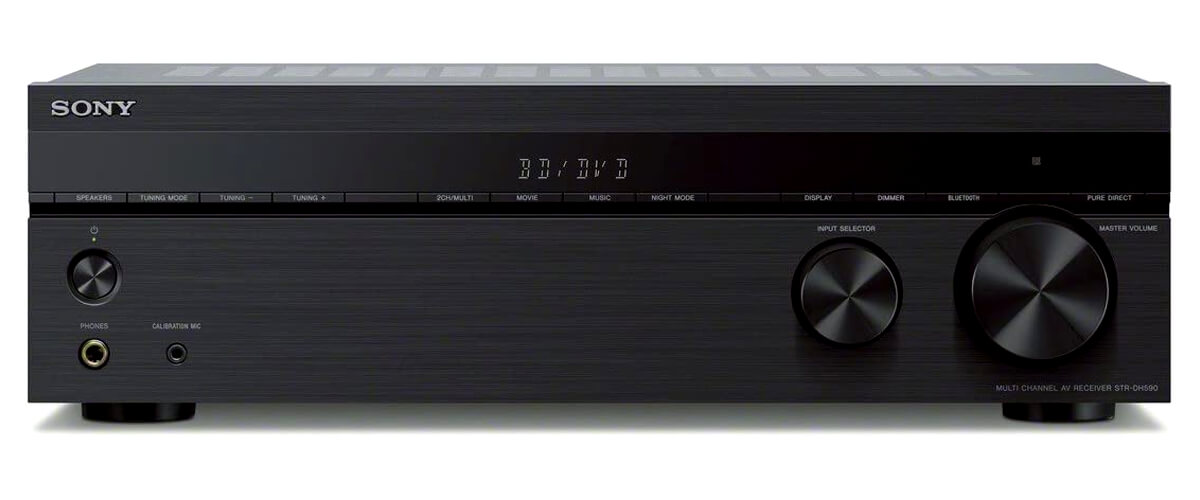
The Sony STR-DH590 is a popular AV receiver that was released in 2018. Sony also wanted to create a sturdy 5.1 home theater receiver to enforce their market percentage. So after hard work, they created the DH590, which has 5.2 channels of sound, is easy to use, has the necessary basic features, and supports 4K HDR video. The unit from Sony is even more affordable than its counterparts, the Yamaha RX-V385 and the Denon AVR-S540BT. Yet, it has certain limitations compared to other units in my review. So, is the Sony STR-DH59 worth the money and fuss?
The Sony STR-DH590 is finished in black and features a pretty unusual design. While Denon and Marantz all follow their traditional partners, Sony clearly takes room for experiments. No, the classic layout with controls, display, and some ports on the front with all other connectivity options on the back is still here, but the unusual positioning of the control surfaces makes it feel new. The control interface is cleanly laid out and simple to use, with dedicated buttons for routine operations like selecting inputs and adjusting volume. I like this, though they could have mastered a more prominent display there. After all, there is still plenty of space on the receiver. Its dimensions are 5.25 x 17 x 11.75 inches, and its weight is also comparatively small — a little less than 16 lbs.
This model delivers 145 watts per channel at 6 ohms. It supports a wide range of speaker impedance, from 6 to 16 ohms. The built-in amplifier of the Sony STR-DH590 has a frequency response range of 20 Hz to 20 kHz and a total harmonic distortion of 0.09%. The receiver does not support bi-amping or multiroom audio, which is a limitation for some users.
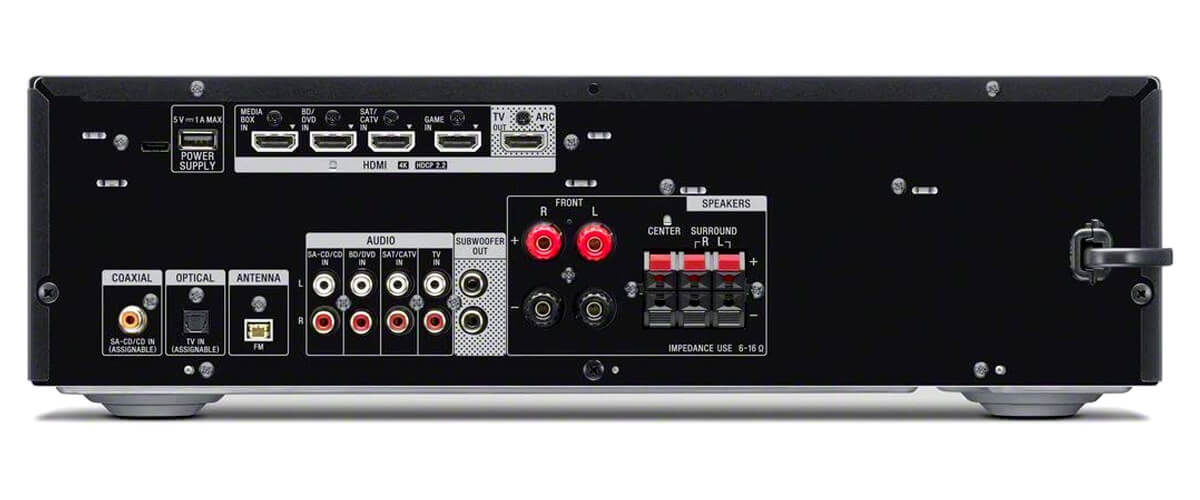
In terms of connectivity, the STR-DH590 has several ports and connectors, including four HDMI inputs and single HDMI output, all of which support 4K HDR with HDCP 2.2. Other inputs and outputs include one optical audio input, single coaxial audio input, and one 3.5 mm audio input. It does not have a phono stage, which means that users will need a separate preamp if they want to connect a turntable. It also supports Bluetooth connectivity, allowing users to stream music from their smartphones or tablets. The previous generation of the unit missed Bluetooth whatsoever.
The DH590 supports various video features, including the previously mentioned 4K HDR with HDCP 2.2, Dolby Vision, and Hybrid Log-Gamma. At the same time, the unit doesn’t offer HDR+ technology, but it has a proprietary BRAVIA SYNC (CEC Control). When I tested it in movies, the only problem I found was that sometimes upscaling is just too visible. However, in every other aspect, the unit performed well. And if we think again about its budget, I think it’s the best budget 5.2 receiver available now.
Talking about audio features, Sony STR-DH590 supports a range of sound features, including DTS-HD and Dolby TrueHD decoding. I tested the receiver in music, gaming, and, of course, movies. Starting from the latter, I noticed one of the coolest in its class separation between channels. In turn, this resulted in pure, distortion-free dynamic sound. At the same time, when movies throw dozens of explosions, it is clear that the STR-DH590 could truly benefit from a more powerful bass. Because now, it is a bit pale even with my high-end woofer.
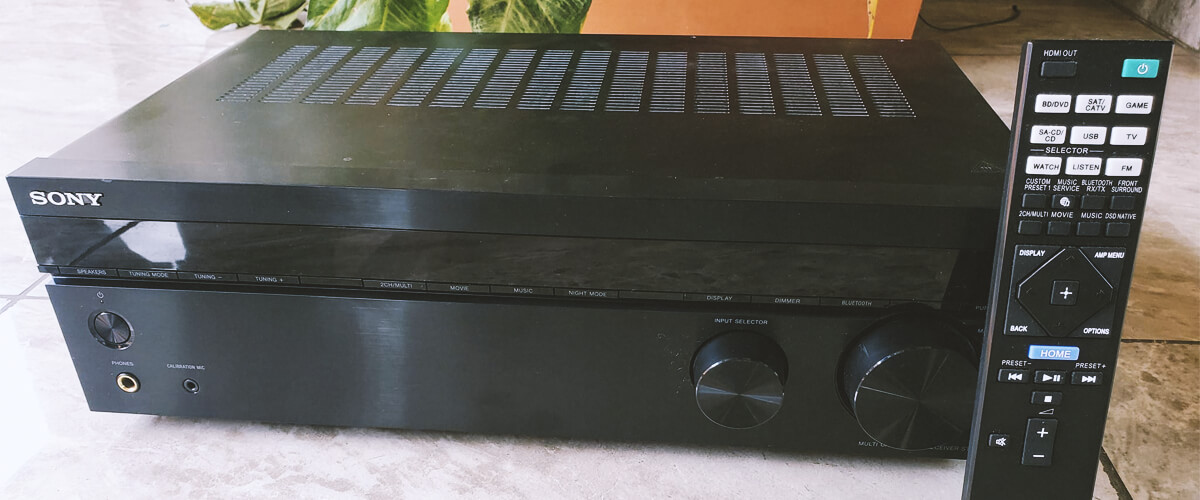
I also would like to note the auto sound calibration system of the Sony STR-DH590 uses Sony’s Digital Cinema Auto Calibration (DCAC) technology. It serves to optimize the sound performance based on the acoustics of the room. While this technology is not as advanced as some other calibration systems on the market, it still effectively improves the overall sound quality of the receiver.
My music and gaming experience weren’t disappointing too. And again, the bass section could have been way better, which is heard in games. But, at the same time, music sounds balanced and optimal. Indeed, the unit won’t deliver a miracle sound but can provide quality music that brings joy.
The Sony STR-DH590 may not be up to par for modern receivers because, let’s be honest, it was released in 2018. Back then, you hadn’t heard of 8K video yet, and streaming services weren’t that popular. But given its incredibly low price, it’s amazing at what level it still holds the bar. This AVR hasn’t left the charts in years, and that’s a testament to the fact that it does its job well. You have 5-channel surround sound, good 4K video, and Bluetooth. It’s unreliable, and at max volume, it makes horrible distortions. It overheats if you torture it for too long. But friends, you can easily replace it at any time. Or consider the more expensive models I’ve already mentioned.
Key specs
- Channels: 5.2.
- Power output: 145W/6 Ohm.
- HDMI inputs/outputs: 4/1.
- Video functions: 4K/60Hz pass-through.
- Bluetooth/Wi-Fi: yes/no.
- Streaming services: no.
- Suppots: HDCP2.2, HDR10, Dolby Vision.
- Surround sound: DTS HD Master, Dolby Digital.
Pros
- Affordable price.
- Sony’s Digital Cinema Auto Calibration.
- Great sound separation between channels.
Cons
- Limited HDMI Inputs.
- No Wi-Fi Connectivity.
- Could have been more powerful.
Yamaha RX-V385
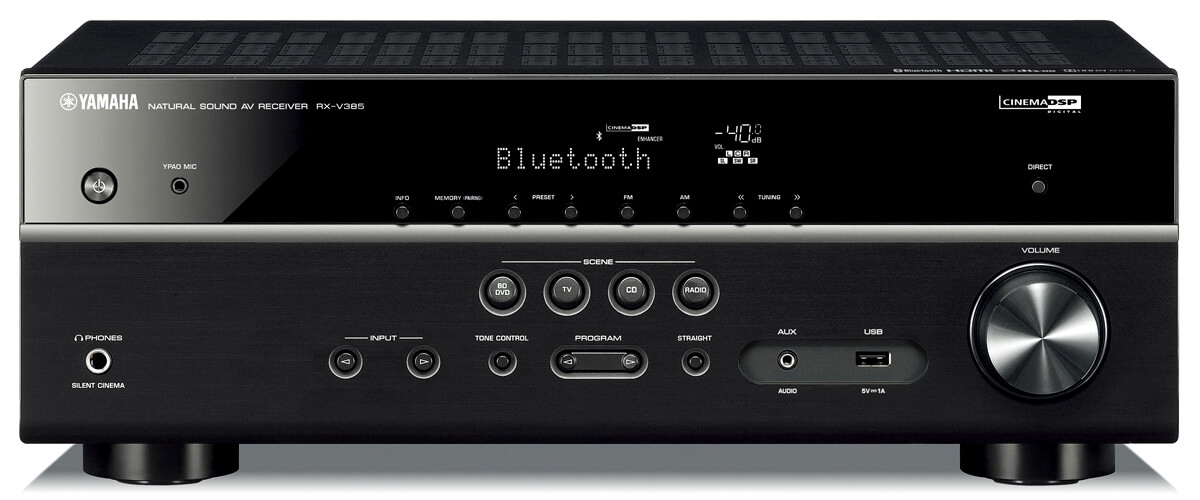
Yamaha launched the RX-V385 in 2018 and positioned it as a budget solution that must be ideal for home theaters for people who want access to new technologies at a fair price. However, when testing it, I often thought it was important to remember that this is an entry-level receiver because it showed itself capable. That’s also why I often compared the Yamaha RX-V385 to the Sony STR-DH590 and the Denon AVR-S660H. These models are similarly priced and aimed at budget-conscious consumers who want to improve their home audio experience.
The Yamaha RX-V385 boasts a contemporary and streamlined appearance akin to other Yamaha AV receivers. It looks very refreshing and scores a point in my eyes. Its robust build quality gives the impression of a firm and excellently crafted receiver. The control surfaces are well-designed, with easy-to-read labels and intuitive controls. The remote is also user-friendly and easy to navigate. In terms of size, the Yamaha RX-V385 measures 17-1/8″ x 6″ x 12-3/8″ (W x H x D) and weighs 17 pounds.
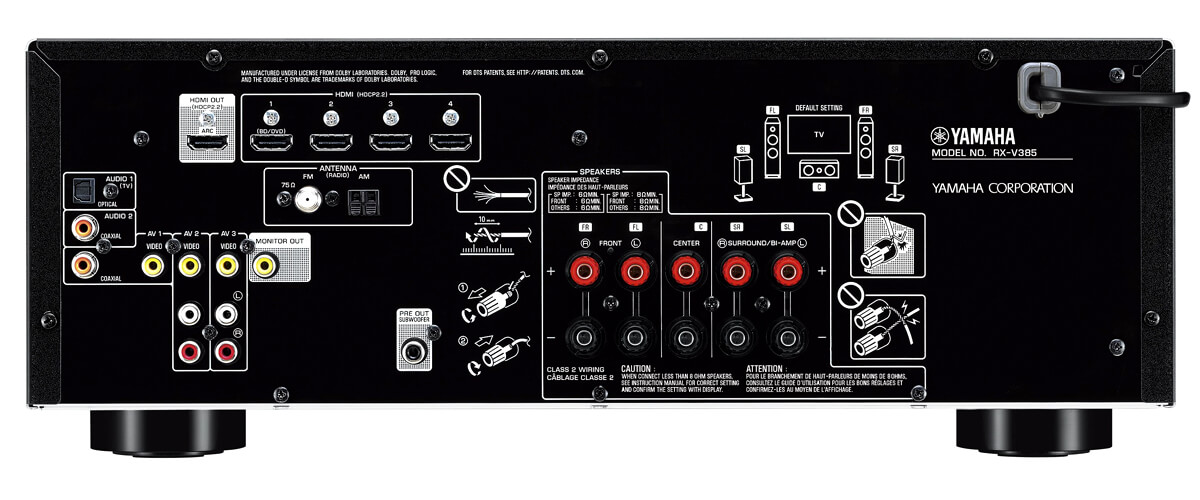
The Yamaha RX-V385 is a 5.1-channel AV receiver that is rated at 70 watts per channel at 8 ohms. The unit is compatible with speakers that have an impedance of 6–16 ohms. The Yamaha RX-V385 has a built-in amplifier and DAC (Burr-Brown 384 kHz / 32-bit DAC x 3), with a frequency response of 20 Hz—20 kHz and a total harmonic distortion (THD) of 0.09%.
Regarding connectivity, the Yamaha RX-V385 has four HDMI inputs and one HDMI output, supporting 4K/60p, HDR10, and Dolby Vision. And again, the unit lacks the support of HDRD 10+. It also has a phono input, optical and coaxial digital inputs, and an analog audio input. Returning to the bad, the Yamaha RX-V385 doesn’t have built-in Wi-Fi, but it does have a USB port that can be used to connect to external devices. It also has support for streaming services like Spotify and Pandora.
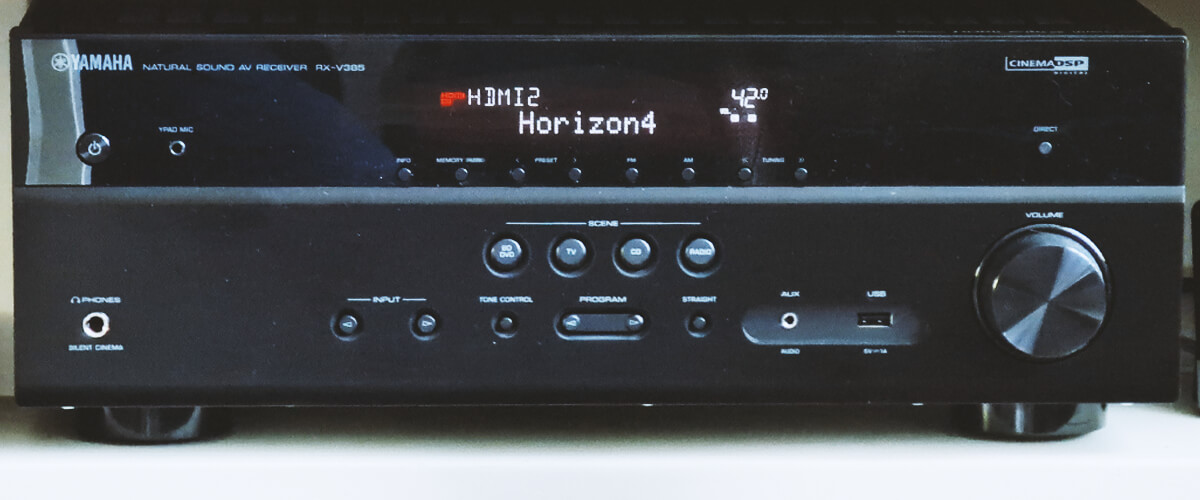
The Yamaha RX-V385 offers a quality audio experience for its price point. But still, my tests showed that compared to the Sony STR-DH590 and Denon AVR-S660H, even though the RX-V385 holds up well in audio performance, it still misses certain aspects and features. During my tests in movies, the unit offered a good balance of bass and treble. The receiver’s Cinema DSP 3D technology also adds a noticeable improvement to the overall sound experience and even works nicely to improve the sound in music. Yet, picking the RX-V385 solely for music is far from a great idea.
The Yamaha RX-V385 delivers decent performance at an affordable price, as expected. Despite lacking many modern features, the RX-V385 is still an alternative choice in the budget AV receiver market. For me, it’s between the Denon AVR-S660H, as it offers reliable average quality, and the Sony STR-DH590, as it’s inexpensive and lacks modern features (no 8K video transfer and no Wi-Fi). Nevertheless, I would prefer Sony because Yamaha has a specific ringing, crystalline sound, which many people like, and many – absolutely not (unlike competitors’ warm, realistic tones). And although this is a subjective opinion, it is reflected among users.
Key specs
- Channels: 5.1.
- Power output: 70W/8 Ohm, 130W/6 Ohm.
- HDMI inputs/outputs: 4/1.
- Video functions: 4K/60Hz pass-through, upscales HD video signals to 4K Ultra HD.
- Bluetooth/Wi-Fi: yes/no.
- Streaming services: no.
- Suppots: HDMI ARC, HDMI eARC, HDMI CEC, HDMI Upscaling.
- Surround sound: DTS HD Master, Dolby TrueHD, Dolby Digital Plus, Cinema DSP.
Pros
- The affordable price for an entry-level AV receiver.
- Great chassis quality and attractive design.
- Good audio performance with a balanced sound.
Cons
- No support for HDR10+.
- Lacks built-in Wi-Fi.
Pioneer VSX-534
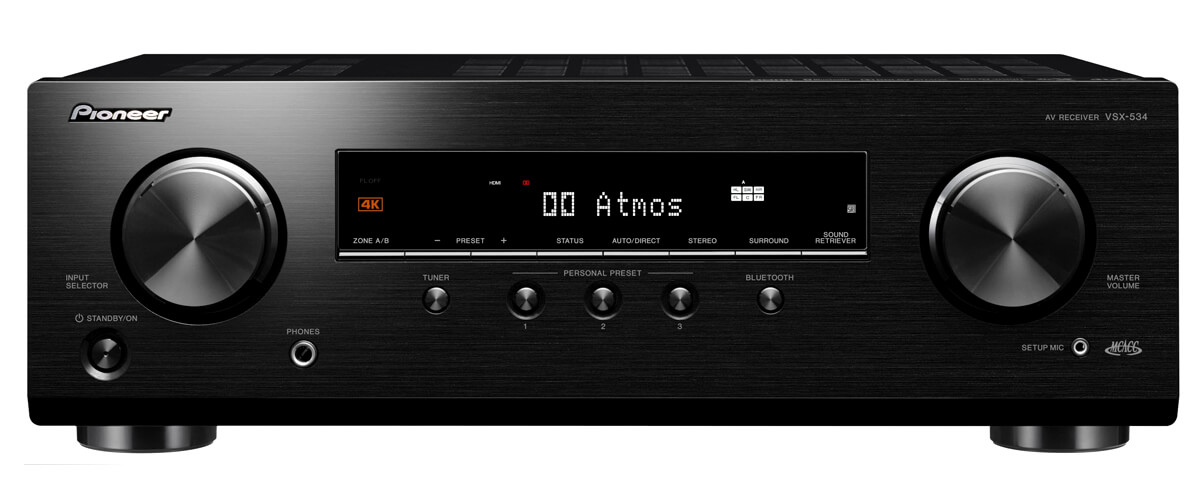
In my search for the best 5.1 AV receiver, I found the Pioneer VSX-534, released in 2019. Pioneer also wanted to join the fight for market share, of course, aimed to make it one of the cheapest solutions that would still provide its buyers with quality sound and rich features. Is it a versatile and easy-to-use option for those looking to enhance their home entertainment experience? Let’s look at it from different angles and evaluate this rather interesting model.
The Pioneer VSX-534 has a relatively simple and understated design. It is a black box with a brushed finish on the front panel and a compact form factor. The receiver’s build quality is solid and feels sturdy and well-made. The control surfaces are straightforward and intuitive, with minimal buttons and knobs. The receiver’s dimensions are 5.9 x 17.1 x 12.6 inches, weighing 16.3 lbs.
The Pioneer VSX-534 is a 5.2-channel AV receiver that can deliver up to 140 watts per channel. It supports speakers with an impedance of 6–16 ohms. The built-in amplifier in the Pioneer VSX-534 has a frequency response of 10 Hz—100 kHz and a total harmonic distortion (THD) of 0.08%.
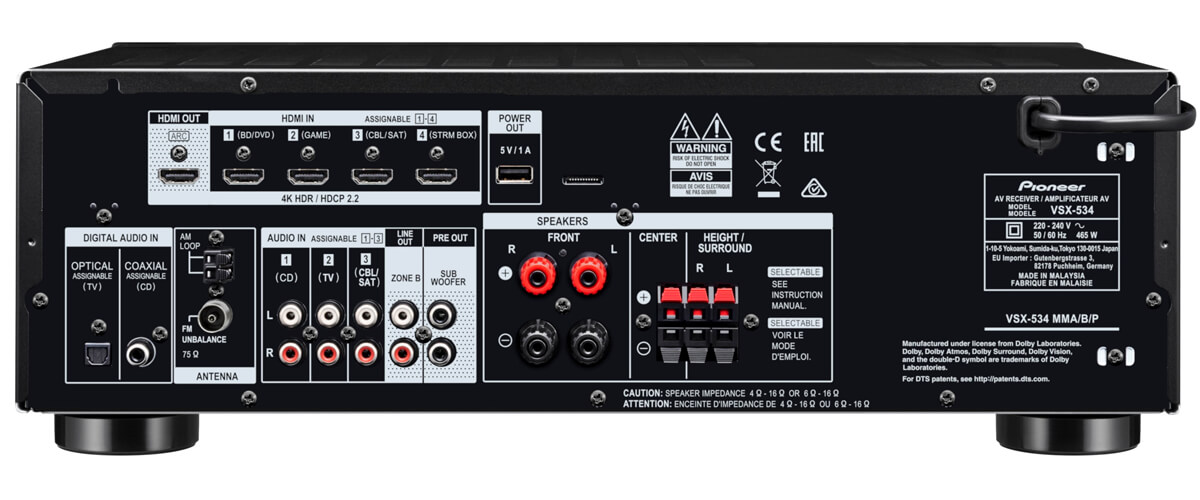
The VSX-534 features 4 HDMI inputs and a single HDMI output. The receiver also has a range of other inputs and outputs, including optical and coaxial digital inputs, RCA analog inputs, USB, ZONE B Line Out for Wireless Headphones, and a subwoofer output. It also has an FM/AM antenna on the back.
It supports Ultra HD with HDCP 2.3, offering crisp and clear visuals in 4K with high bit depth and color accuracy. The receiver also supports HDR10, HLG, and BT.2020 Wide Color Gamut Signal Pass through, allowing for a wider range of colors and brighter whites. Additionally, it is Dolby Vision compatible, making it perfect for streaming services that offer this format. The Pioneer VSX-534 also features ultra HD upscaling, which enhances your standard 1080p videos to 4K quality. It is 3D-ready and supports deep color (36-bit).
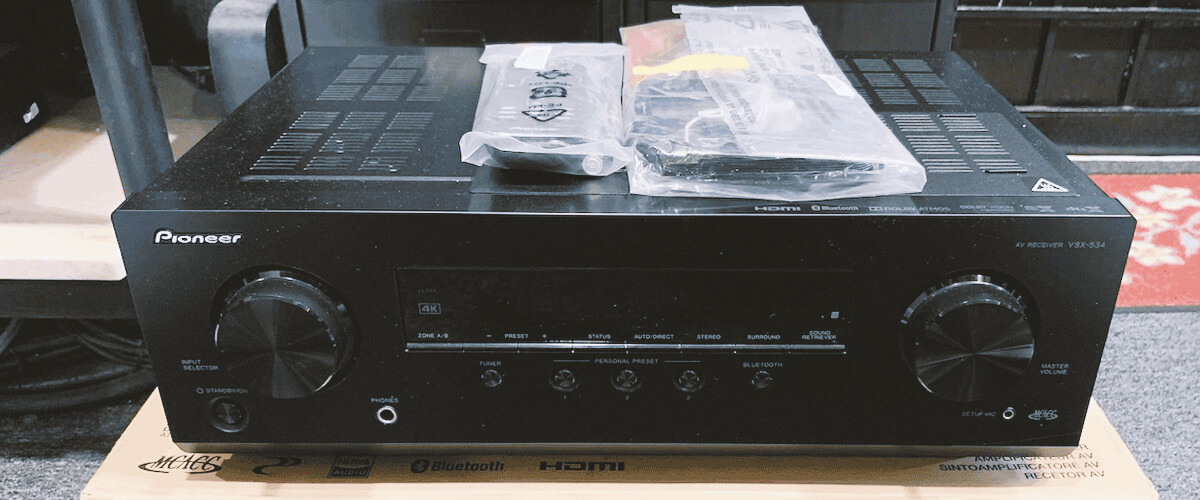
The receiver has various audio features, including Dolby Atmos and DTS:X for and Dolby Surround and DTS Neural:X Upmixers to upscale non-surround sound to a surround-like experience. I tested this feature, and it indeed does what it says. The Reflex Optimizer helps ensure the clarity of object-based audio reproduction, while the Dolby Atmos Height Virtualizer. The VSX-534 also features MCACC Auto Room Tuning, which optimizes the sound to the room’s size, shape, and acoustics.
The Pioneer VSX-534 is a capable unit. I can’t tell that it is the most valuable option, but it is still a unit to consider, and here is why. During my tests, the unit offers a stunning sound placement. I could hear every separate speaker, but simultaneously, they created a symphony of immersive sound when working together, just like with the Denon AVR-S660H. Yet, this unit is less valuable because it shows lesser performance in music, especially when using modes. Sometimes, the music sounded way out of the instruments that played it.
The Pioneer VSX-534 will probably appeal to fans of the brand. For all its outward appearance, solid construction, and good sound, it still doesn’t offer 8K video like the Denon AVR-S660H, it doesn’t have the versatility for movies and music, and its MCACC calibration system is a toy that doesn’t compare to even the most primitive Audyssey (Denon and Marantz). You’ll have to manually adjust frequencies, though it’s not terrible for this budget. It also doesn’t have many HDMI ports. So, for me, the choice is obvious. I’m a bit disappointed with this model, as Pioneer is capable of more, and it’s long overdue for them to update the 5-channel model so it can compete decently. This high-power 5.1 AV receiver is better than the Sony STR-DH590 or Yamaha RX-V385, but you can’t see that with the naked eye.
Key specs
- Channels: 5.2.
- Power output: 80W/8 Ohm, 150W/6 Ohm.
- HDMI inputs/outputs: 4/1.
- Video functions: 4K/60Hz pass-through, upscales HD video signals to 4K Ultra HD.
- Bluetooth/Wi-Fi: yes/no.
- Streaming services: no.
- Suppots: HDMI ARC, HDMI eARC, HDMI CEC, HDMI Upscaling, HDMI HDR, HDMI HGL.
- Surround sound: Dolby Atmos, DTS:X, DTS Neural:X, DTS Virtual:X, DTS HD Master, Dolby TrueHD, Dolby Digital Plus, Dolby Atmos Height Virtualizer.
Pros
- Affordable price point for an entry-level AV receiver.
- Supports Dolby Vision.
- Features MCACC Auto Room Tuning.
Cons
- Less performance in music, especially when using modes.
- Only has 4 HDMI inputs, which may be limiting for some users with multiple devices to connect.
- Lacking visual appeal for those who prefer a more visually striking device.
FAQ
What is the difference between 5.1 and 5.2 receivers?
Is 5.1 or 7.1 surround sound better?
The immersive audio experience that a 5.1 or 5.2 system offers is its principal benefit. The 5.1 system’s compatibility with the majority of home theater receivers and ease of setup are further benefits. More crucially, a 5.1 home theater receiver strikes a nice mix between price and performance, making it a popular choice.
On the other hand, 7.1 surround sound expands the audio space by adding two extra speakers to the setup’s back. For individuals who prefer a more immersive audio experience or for bigger spaces, this arrangement can offer an even more immersive audio experience. However, it’s crucial to remember that not all video is produced in 7.1 surround sound, so you might not always experience the full potential of the extra speakers. Also, the extra speakers might not be useful or essential for smaller spaces or configurations.
Does Netflix support 5.2 surround sound?
Does Amazon Prime have 5.1 surround sound?
Can you get 5.1 through optical cable?
Yes, using an optical connection to deliver 5.1 surround sound is possible. Generally, up to 5.1 channels of uncompressed audio may be sent using the optical connection. This implies that you may use an optical cable to obtain 5.1 surround sound if your source device (such as a Blu-ray player, gaming console, or streaming device) and your AV receiver both support it and have an optical input/output.
It’s important to keep in mind that certain more recent audio formats, including Dolby Atmos and DTS:X, demand more channels than the conventional 5.1 settings. So to enjoy the sound quality in this situation, you need to use HDMI connections and an AV receiver that supports these more modern codecs.

